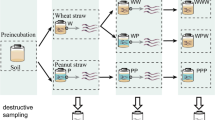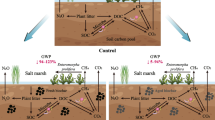Abstract
Impacts of different habitats on specific activities of LDH, cMDH, mMDH, cytoplasmic and mitochondrial proteins of M. posthuma, P. sansibaricus, L. mauritii were studied. Maximum specific activity of LDH of the earthworm M. posthuma and L. mauritii was observed in garden. In case of P. sansibaricus, maximum LDH specific activity was found in sewage. Minimum specific activity of LDH of the earthworm M. posthuma was found in non-cultivated field. However, P. sansibaricus and L. mauritii exhibited minimum activity in orchard and cultivated pedoecosystem, respectively. The maximum specific activity of cMDH and mMDH in earthworms from sewage and minimum from non-cultivated field (in case of M. posthuma), garden (in P. sansibaricus) and cultivated land (in L. mauritii) may be due to availability of more organic matter and nitrogen content in the former than in the later cases. Variations in specific activities of these metabolic enzymes due to changes in their pedoecological habitats clearly demonstrate the impact of pedoecosystem on respiratory capacity of the earthworms. Earthworms from pedoecosystem richer in organic matter and nitrogen showed elevated levels of cytoplasmic and mitochondrial protein. The changes in enzyme-specific activity and protein profiles were habitat specific.





Similar content being viewed by others
References
Bouche MB (1977) Strategies lombricienns. Ecol Bull (Stockholm) 25:122–132
Boyd JM (1958) The ecology of earthworms in cattle-grazed machair in Tiree. Argyll J Anim Ecol 27:147–157
Childress JJ, Somero GN (1990) Metabolic scaling: a new perspective based on scaling of glycolytic enzyme activities. Am Zool 30:217–229
Dash MC, Senapati BK (1980) Cocoon morphology, hatching and emergence pattern in tropical earthworms. Pedobiologia 20:316–324
Edwards CA, Lofty JR (1977) Biology of earthworms. Chapman and Hall, New York, p 333
Foster GD, Moon TW (1986) Cortisol and liver metabolism of immature Americans eel, Anguilla rostrata (LeSueur). Fish Physiol Biochem 1:113–124
Gates GE (1972) Burmese earthworms. An introduction to the systematic and biology of megadrile oligochaetes with special reference to southeast Asia. Trans Am Phil Soc 62:1–326
Govindan VS (1998) Vermiculture and vermicompostings. In: Trivedy RK, Kumar A (eds) Ecotechnology for pollution control and environmental management. Enviro Media, Karad, pp 49–58
Horecker BL, Kornberg A (1948) The extinction coefficients of the reduced band of pyridine nucleotides. J Bio Chem 175:385–390
Julka JM (1988) The Fauna of India and the adjacent countries. Megadrile: Oligochaeta (Earthworms). Haplotaxida: Lumbricina: MegascolecoideaL Octochaetidae, XIV + 400 p. Zoological Survey of India, Calcutta
Kale RD, Krishnamoorthy RV (1981) Litter preference in the earthworm Lampito mauritii. Proc Indian Acad Sci (Anim. Sci.) 40:123–128
Kollmannsperger F (1956) Lumbricidae of humid and arid regions and their effect of soil fertility VI Congr. Inst. Sci. Sol. Rappp. C., pp 293–307
Kubiena WL (1953) Bestimmungsbuch and Systematik der Boden Europas, Stuttgart, p 392
Lavelle P (1974) Lesvers de terre de la savane de Lampto. In: Analyse d’un Ecosysteme Tropicale Humide: la Savane de Lampto (Cote d’Ivoire). Bull De Liason des Chercheurs de Lampto (Paris) 5:133–136
Lee KE (1985) Earthworms: their ecology and relationship with soils and land use. Academic Press, London 411 p
Lowery OH, Rosebrough NJ, Farr AL, Randall AJ (1951) Protein measurement with the folin phenol reagent. J Bio Chem 193:265–275
Nainawat R, Bhardwaj N (2003) Variations in earthworm density, biomass and cast production in garden and cultivated soils of semi-arid zone. Indian J Ecol 30:152–158
Neilson R, Boag B, Smith M (2000) Earthworm δ13C and δ15N analysis suggest that putative functional classifications of earthworms are site-specific and may also indicate habitat diversity. Soil Boil Biochem 32:1053–1061
Phillipson J, Abel R, Steel J, Woodell SRJ (1976) Earthworms and the factors governing their distribution in an English beechwood. Pedobiologia 16:258–285
Pörtner HO (2002) Climatic variations and the physiological basis of temperature dependent biogeography: systematic to molecular hierarchy of thermal tolerance in animals. Comp Biochem Physiol 132:739–761
Reynolds JW (1973) Earthworms (Annelida: Oligochaeta) ecology and systematics. In: Dindal DL (ed.) 1st Soil microcommunities conference of national technical information services, Springfield, USA, pp 95–120
Satchell JE (1955) Some aspects of earthworm ecology. In: Zoology Soil, Kervan DKME (eds) Butterworths. London, England, pp 180–201
Schwantes MLB, Schwantes AR (1982) Adaptative features of ectothermic enzymes-I temperature effects on the MDH from a temperate fish, Leiostomus xanthurus. Comp Biochem Physiol 72:49–58
Tripathi G, Bhardwaj P (2004) Earthworm diversity aqnd habitat preferences in arid regions of Rajasthan. Zoos’ Print J 19:1515–1519
Tripathi G, Sharma BM (2005) Effects of habitats and pesticides on aerobic capacity and survival of soil fauna. Biomed Environ Sci 18:169–175
Author information
Authors and Affiliations
Corresponding author
Rights and permissions
About this article
Cite this article
Tripathi, G., Kachhwaha, N., Dabi, I. et al. Habitat-associated changes in some metabolic dehydrogenases and proteins of tropical earthworms. Environmentalist 30, 171–177 (2010). https://doi.org/10.1007/s10669-010-9262-0
Published:
Issue Date:
DOI: https://doi.org/10.1007/s10669-010-9262-0




